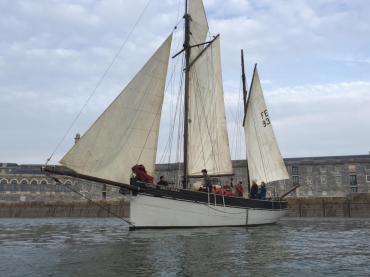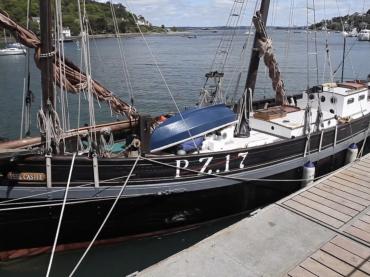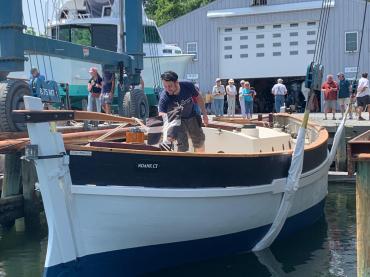


Details
Construction
Dimensions
History
MARY JOSEPH is a vernacular boat type known as a nickey. These were large carvel-built sailing drifters, or drivers, with lug sails fore and aft, famed for their speed. They needed a relatively large, skilled crew to sail them, but that meant they had a full complement of muscle for hauling the drift nets they deployed.
The nickey originates from Cornwall but was adapted by fishermen from the Isle of Man and later those from the Co. Down harbour of Kilkeel. Although west Cornish fishermen had been coming to the Irish Sea herring fishery from 1818, it was their outstanding success at the Kinsale mackerel fishery in the 1860s that stimulated an unprecedented demand for the superior west Cornish lugger. Penzance and St Ives boat builders were inundated with orders, especially from Manx fishermen, who called their new Cornish luggers ‘nickeys’. It was in anticipation of a continuing demand for Cornish luggers that the entrepreneurial boat builder William Paynter, was encouraged to leave St Ives in 1875 and establish a boatyard in Kilkeel.
Kilkeel town is the main fishing port on the Down coast, and its harbour houses one of the largest fishing fleets in Ireland. The first harbour was built at Kilkeel in 1860 and during the late nineteenth and early twentieth century it became a major centre for the Irish herring fishery. However, the mackerel fishery went into decline shortly after MARY JOSEPH was built by Paynter in 1877, and he sold his Kilkeel yard in 1883 and returned to St Ives. The yard was bought by his apprentice John McIntosh and the main fish caught became herring and later prawn.
MARY JOSEPH represents a way of life of the region and the importance of the fishing industry to the people that lived there. Built in 1877, she was registered in Newry (N) and allocated the number 55. She was motorised in 1920 and has strong regional significance as the first fishing vessel in Kilkeel harbour to be equipped for prawn fishing in 1954. The catches were bought by an Annalong firm and sent to two canning factories in Ardglass and Belfast highlighting the vital role the boat played in the fishing industry in several towns in the east of the province. She is one of the last original fishing vessels from the east coast of Northern Ireland at over 130 years old.
MARY JOSEPH has an interesting link to the First World War. On 17 May 1918 the Kilkeel fleet left the harbour to drift net for herring. At daylight the next morning, on 18 May, a German submarine surfaced in the middle of the fleet, UB-64 under the command of Otto von Schrader, and ordered the crews into the punts and told them to come along the side of the submarine. They were then ordered on to the deck. One of the German officers then proceeded to place a bomb on each boat. The subsequent explosions sank the five boats.
The names of the boats were: NEVER CAN TELL, JANE GORDON, CYPRESS, ST MARY and LLOYD. Some of the boats had no punt and the captain ordered them on to another fishing boat, the MOSS ROSE, and let them row for home. There is some debate as to whether MARY JOSEPH was not fishing in the same area, and so she wasn't seen by the submarine, or she had helped bring some of the fisherman back to shore along with the MOSS ROSE but she was certainly in the waters that day and there was much rejoicing in Kilkeel when she returned safely along with the other fishermen.
MARY JOSEPH continued fishing for almost 100 years until she was retired and purchased by the Ulster Folk & Transport Museum on 10 Dec 1973 from the skipper/ owner Thomas Curran from Newry Street, Kilkeel. She was initially placed on a borrowed mooring in Strangford Lough, about ¾ mile from Ringhaddy quay. She was checked and pumped weekly and from July 1974, Museum staff had to borrow rowing boats from local owners to access her. She was later displayed outside the Museum galleries and then moved to an off-site store on 13 March 2004. The entrance door needed to be modified to allow entry and she was the first collection item housed there.
On 13 June 2024, National Museums NI announced its intention to commence deconstruction Mary Joseph unless any viable alternative solution is put forward before the deadline of midday on Monday 9 December 2024. Read the full Declaration of Intent to Deconstruct: https://www.nationalhistoricships.org.uk/news/nhs/declaration-intent-deconstruct-national-historic-fleet-vessel-mary-joseph. Further updates on the planned ethical deconstruction are available on the NMNI website: Mary Joseph | National Museums NI.
Significance
1. What is the vessel’s ability to demonstrate history in her physical fabric? Evidence for designs, functions, techniques, processes, styles, customs and habits or uses and associations in relation to events and people. How early, intact or rare these features are may impact on significance.
MARY JOSEPH is a vernacular boat type known as a nickey. She is constructed of wooden planks on sawn oak frames, with a mixture of both single and double frames. She has undergone modifications during her working life with her stem no longer original and likely to date from a time when her sheer line was raised. Stealers are fitted on the hull below the sheer plank forward, also from the time the sheer was raised and are not part of the original vessel. An engine was fitted in the 1920s and a wheelhouse added at some stage. The current interior is divided between an engine room and the hold, with the crew accommodation in the aft section. The vessel has been subject to considerable structural decay, and deformation within the hull, decks, keel and framing is severe. The rudder is breaking away from the stern post and the two engines which remain in-situ with associated gearboxes, transmission and operating systems are adding to the risk of structural failure by the weight they bring.
2. What are the vessel’s associational links for which there is no physical evidence?
Associations with people or places. Off-ship research.
MARY JOSEPH was built in Kilkeel in 1877 by the famous Cornish boat builder William Paynter, who had moved to the area from St Ives in 1875 to establish a boat yard to supply craft to the Isle of Man. The manxmen had seen the nickeys at work in the expanding and hugely valuable Spring mackerel fishery in Irish waters off Kinsale, and Cornish boatbuilders had been inundated with their orders for them. The Kinsale mackerel fishery was based on the supply of cured fish to American markets. The first harbour was built at Kilkeel in 1860 and during the late nineteenth and early twentieth century it became a major centre for the Irish herring fishery with vessels like MARY JOSEPH supporting a national industry.
MARY JOSEPH has strong regional significance having worked out of Kilkeel, the main fishing port on the Down coast and home to one of the largest fishing fleets in Ireland. She represents a way of life for this region and demonstrates the importance of the fishing industry to the people that lived there. She is one of the oldest fishing boats originally built in Kilkeel and her builder was renowned along the Cornish coast. She was also the first fishing vessel in Kilkeel to be equipped for prawn fishing in 1954. The catches were bought by an Annalong firm and sent to two canning factories in Ardglass and Belfast highlighting the vital role the boat played in the fishing industry in several towns in the east of the province.
MARY JOSEPH is one of the last original fishing vessels from the east coast of Northern Ireland and as such, was purchased by the Ulster Folk & Transport Museum in the 1970s. There is very limited documentation on her and the only images were taken after she became part of the museum collection. MARY JOSEPH was added to the National Register of Historic Vessels in 1996 and given the status of being on the National Historic Fleet.
3. How does the vessel’s shape or form combine and contribute to her function?
Overall aesthetic impact of the vessel, her lines, material she was built from and her setting. Does she remain in her working environment?
MARY JOSEPH is a standard nickey design making her ideal for the purpose for which she was built, to fish for mackerel as part of the Kilkeel fishing industry. Nickeys were large carvel-built sailing drifters, or drivers, with lug sails fore and aft, famed for their speed. They needed a relatively large, skilled crew to sail them which meant they had a full complement of muscle for hauling the drift nets they deployed. The mackerel fishery went into decline shortly after MARY JOSEPH was built in 1877 and the main fish caught became herring and later prawn. She was adapted for this work instead, fitted with an engine in the 1920s and continued fishing for almost 100 years until she was retired. In her original form with lug rigged sails, MARY JOSEPH would have been visually pleasing as a functional working vessel. She is now in static preservation, housed in an off-site store at the Ulster Folk & Transport Museum.
Author:
Clare Ablett, National Museum of Northern Ireland
2/2/22
Sources
Brouwer, Norman J, International Register of Historic Ships, Anthony Nelson, pp161, Edition 2, 1993
Sullivan, Dick, Old Ships, Boats and Maritime Museums, Coracle Books, 1978
Own this vessel?
If you are the owner of this vessel and would like to provide more details or updated information, please contact info@nationalhistoricships.org.uk





